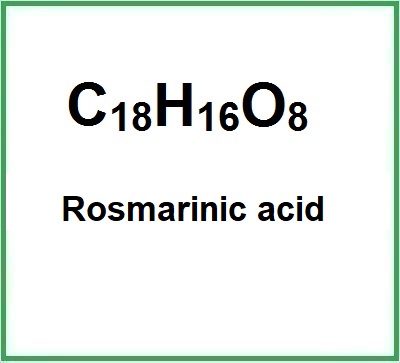What is rosmarinic acid?
It is an ester of two acids: caffeic acid and 3, 4-dihydroxyphenyllactic acid.
From where it is extracted?
It is mainly extracted from plants of three families and botanical subfamilies: Lamiaceae, Boraginaceae and Nepetoideae
What is it for?
Rosmarinic acid is one of the most important and well-known polyphenolic antioxidants that is abundant in various medicinal plants of the Lamiaceae family which include Rabdosia rubescens (Hemsl.) H. Hara., R. amethystoides (Benth.) Hara., Rosmarinus officinalis L., Perilla frutescens (L.) Britton, and Salvia miltiorrhiza Bunge. It is a folk remedy that is commonly used for the prevention and treatment of hepatobiliary diseases.Several studies have reported the role of rosmarinic acid and its pharmaceutical and biotechnological effects; for example, anti-colitic, antioxidant, anti-inflammatory, anti-leukemic, and anti-hepatic ischemia activities, as well as neuroprotective effects (1).
Atherosclerosis is widely known to be a chronic inflammatory disease. C-reactive protein (CRP), an important inflammatory factor, plays an essential role in the pathogenesis of atherosclerosis. Nicotine, the main addictive component of cigarette, has been shown to induce the production of CRP. The aim of this study was to investigate the effect of rosmarinic acid (RA), a polyphenol with antiinflammatory activity, on nicotine-induced elevation of CRP in vascular smooth muscle cells (VSMCs). We found that pretreatment of VSMCs with RA attenuated nicotine-induced expression of CRP in a time- and dose-dependant manner. In addition, RA also inhibited the activation of NLR family pyrin domain containing 3 (NLRP3) inflammasome and reactive oxygen species (ROS) production resulting from nicotine treatment in VSMCs. To confirm these findings in vivo, we constructed a nicotine-induced atherosclerosis rat model. RA did not significantly reduce the serum nicotine level of the rats, whereas it significantly decreased the levels of serum lipids, including concentrations of cholesterol, triglycerides, and low-density lipoprotein cholesterol, and the serum level of CRP. RA also led to diminished nicotine-induced activation of NLRP3 inflammasome and elevation in the CRP level in the aortic tissue of the model rats. The results of this study suggested a protective role of RA in nicotine-induced atherosclerosis by inhibiting the ROS-NLRP3 inflammasome-CRP axial, and RA therefore represented a potential effective therapeutic approach to atherosclerosis, in particular for those who smoke (2).
Cataract, the leading cause of vision impairment worldwide, arises from abnormal aggregation of crystallin lens proteins. Presently, surgical removal is the only therapeutic approach. Recent findings have triggered renewed interest in development of non-surgical treatment alternatives. However, emerging treatments are yet to achieve full and consistent lens clearance. Here, the first ex vivo assay to screen for drug candidates that reduce human lenticular protein aggregation was developed. This assay allowed the identification of two leading compounds as facilitating the restoration of nearly-complete transparency of phacoemulsified cataractous preparation ex vivo. Mechanistic studies demonstrated that both compounds reduce cataract microparticle size and modify their amyloid-like features. In vivo studies confirmed that the lead compound, rosmarinic acid, delays cataract formation and reduces the severity of lens opacification in model rats. Thus, the ex vivo assay may provide an initial platform for broad screening of potential novel therapeutic agents towards pharmacological treatment of cataract (3).
It has a protective action against liver injuries (4).
Chemioresistance has proved to be a big problem in cancer chemotherapy. This study investigated the positive effect of rosmarinic acid (RA) on 5-Fu chemoresistance and its molecular mechanism in gastric carcinoma (5).
As rosemary Rosmarinus officinalis L. (Lamiaceae), is one of the plants from which rosmarinic acid is extracted, this study examined the antioxidant, hepato-protective, antimicrobial, anti-nociceptive and anti-inflammatory properties that are part of the various biological activities of the secondary metabolites of this plant (6).
Molecular Formula : C18H16O8
Molecular Weight : 360.31
CAS : 537-15-5
Synonyms :
- 3,4-Dihydroxycinnamic acid (R)-1-carboxy-2-(3,4-dihydroxyphenyl)ethyl ester
- (2R)-3-(3,4-dihydroxyphenyl)-2-[(E)-3-(3,4-dihydroxyphenyl)prop-2-enoyl]oxy-propanoic acid
- Benzenepropanoic acid, alpha-((3-(3,4-dihydroxyphenyl)-1-oxo-2-propenyl)oxy)-3,4-dihydroxy-
- Rosemaric acid
References___________________________
(1) Pharmacokinetic and Pharmacodynamic Properties of Rosmarinic Acid in Rat Cholestatic Liver Injury.
Min J, Chen H, Gong Z, Liu X, Wu T, Li W, Fang J, Huang T, Zhang Y, Zhao W, Zhu C, Wang Q, Mi S, Wang N.
Molecules. 2018 Sep 7;23(9). pii: E2287. doi: 10.3390/molecules23092287.
(2) Rosmarinic acid inhibits nicotine-induced C-reactive protein generation by inhibiting NLRP3 inflammasome activation in smooth muscle cells.
Yao Y, Mao J, Xu S, Zhao L, Long L, Chen L, Li D, Lu S.
J Cell Physiol. 2018 Aug 26. doi: 10.1002/jcp.27046.
(3) Rosmarinic Acid Restores Complete Transparency of Sonicated Human Cataract Ex Vivo and Delays Cataract Formation In Vivo.
Chemerovski-Glikman M, Mimouni M, Dagan Y, Haj E, Vainer I, Allon R, Blumenthal EZ, Adler-Abramovich L, Segal D, Gazit E, Zayit-Soudry S.
Sci Rep. 2018 Jun 19;8(1):9341. doi: 10.1038/s41598-018-27516-9.
(4) Rosmarinic acid protects mice from lipopolysaccharide/d-galactosamine-induced acute liver injury by inhibiting MAPKs/NF-κB and activating Nrf2/HO-1 signaling pathways.
Li Z, Feng H, Wang Y, Shen B, Tian Y, Wu L, Zhang Q, Jin M, Liu G.
Int Immunopharmacol. 2019 Feb;67:465-472. doi: 10.1016/j.intimp.2018.12.052. Epub 2018 Dec 28.
(5) Rosmarinic acid reduces the resistance of gastric carcinoma cells to 5-fluorouracil by downregulating FOXO4-targeting miR-6785-5p.
Yu C, Chen DQ, Liu HX, Li WB, Lu JW, Feng JF.
Biomed Pharmacother. 2019 Jan;109:2327-2334. doi: 10.1016/j.biopha.2018.10.061. Epub 2018 Nov 30.)
(6) Rosmarinic Acid as Potential Anti-Inflammatory Agent.
Colica C, Di Renzo L, Aiello V, De Lorenzo A, Abenavoli L.
Rev Recent Clin Trials. 2018;13(4):240-242. doi: 10.2174/157488711304180911095818
![]() Rosmarinic acid
Rosmarinic acid 

